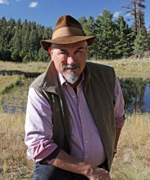— Alan Dulaney
 To the Egyptians of the Middle Kingdom, the first early morning appearance of Sirius, the Dog Star, marked the beginning of the annual Nile flood. The arrival of the life-giving waters created the New Year, born in heat. The ancient Greeks and Romans likewise associated the Dog Star with summer heat and mad dogs, which gave rise to the phrase “dog days of summer.” The phrase stuck, even as Sirius shifted its position relative to the Earth and thus the date of its rising. More recently, “dog days” have come to mean the hot, sultry period from early July to late August, when business activity slows and even baseball games become languid.
To the Egyptians of the Middle Kingdom, the first early morning appearance of Sirius, the Dog Star, marked the beginning of the annual Nile flood. The arrival of the life-giving waters created the New Year, born in heat. The ancient Greeks and Romans likewise associated the Dog Star with summer heat and mad dogs, which gave rise to the phrase “dog days of summer.” The phrase stuck, even as Sirius shifted its position relative to the Earth and thus the date of its rising. More recently, “dog days” have come to mean the hot, sultry period from early July to late August, when business activity slows and even baseball games become languid.
The Nile was naturally cyclical, delivering water to Egypt on a regular basis, which the Egyptians attributed to their gods. The Colorado River also delivers water on a regular schedule but it’s managed by the U.S. Bureau of Reclamation and its hydrologists and water managers. No Egyptian gods here; just numbers and modeling. Water-level elevations in Lake Mead continue to drop and now rest just above 1072 feet, pending deliveries from Lake Powell. All water orders for 2016 for the Lower Basin states and Mexico will be met. Shortage under the 2007 guidelines is not expected in 2017 and, again, deliveries will likely not be shorted. Yet the probabilities of a shortage declaration in 2018 continue to grow, invoking the 2007 shortage-sharing guidelines. And they will become more severe with each increment of water level decline in Lake Mead until no more water can flow to Arizona, only to California.
That is the impetus behind the Drought Contingency Plan, as explained in the Los Angeles Times. Interestingly, the hero of the piece is Tom Buschatzke, Director of ADWR and Arizona’s lead negotiator. No California negotiators are named, perhaps because while Buschatzke is having some success in bringing the various sectors of the Arizona water world together, the California interests are not on the same page. Apparently, not all of them see the need to negotiate a new set of fair guidelines to protect all Lower Basin states if the new guidelines mean that California has to accept any cuts in its Colorado River supply. A recent article in the San Diego paper was very revealing of the strong attitudes of some Californians about sharing any shortage.
So what happens if the Drought Contingency Plan cannot be negotiated within the time frame mentioned in the LA Times article — or even at all? For Arizona, the cuts under the 2007 guidelines hit the CAP canal hardest, with excess water for recharge and the agricultural pool disappearing. Farmers would still need water. This implies that groundwater withdrawals would significantly increase for an extended period. Parts of Arizona might return to a “groundwater mining” situation. In a worst-case scenario, water for the CAP canal would be totally unavailable as early as 2021, and the cities would have to turn on their pumps, too. The San Diego article suggests that some interests in California would find that acceptable, but would the Secretary of the Interior? As Water Master for the Lower Basin, the Secretary could set aside previous agreements and direct Colorado River water to where she thinks it should go. No one knows what that decision might look like, and such uncertainty creates severe anxiety amongst planners and financial markets.
Let’s hope that energetic negotiators can resolve the conflicting demands of all parties, despite the dog days of summer, and produce a Drought Contingency Plan that all interests can live with so the Colorado River, like the Nile, can continue to provide life-giving waters on a regular basis.